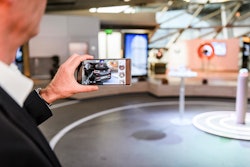Dynamic Road Sign Display
There’s no doubt that our cars are becoming smarter through technology and they’ll only become more intelligent as vehicle-to-vehicle communication becomes more prevalent and the bugs are worked out of self-driving systems. Well Volkswagen has unveiled another car technology called the Volkswagen Dynamic Road Sign Display that makes it easier to track how fast you should be going by flashing an image of the most recent sign in front of the driver.
Using a forward-facing camera to recognize road signs, the system then displays what it sees on the center console, instrument panel or head-up display. The system is able to detect speed signs, highway exit signs, no overtaking zones and motorway ending signs. To ensure correct information, the system will cross-reference the information from the camera with navigation and vehicle data.
Dynamic Road Sign Display will be available on select Volkswagens equipped with the camera and navigation kit with a focus on the European market.
SO, WHAT DO YOU THINK?
Do you think this technology could improve driving safety and navigation? Or could this lead to a more distracted driver? Tell us what you think by leaving your comments below.
Robot Mech Suit
Looking like something straight off the silver screen, the gigantic Method-1 mech suit could offer real-world applications.
Designer Vitaly Bulgarov —known for his futuristic robot designs in recent Terminator and Transformers movies — has teamed up with Korean robotics company Korea Future Technology to bring Method-1 to life.
The 13-foot tall walking mech suit is designed to be functional and houses a pilot that controls the machine’s arm movements from inside. Designers say the intent was to build a reliable robotic platform that could be used effectively in various utilitarian applications.
Currently, Method-1 is capable of walking — forward and backwards on flat surfaces — however rotating ankle joints could allow a finished model to tackle variable terrain.
The robot also has Individual fingers that offer potential dexterity for more precise tasks. Method-1 also Footy
Fcurrently needs to be tethered to a power source.
Vitaly says shot-term uses could include industrial indoor applications where tethers aren’t an issue. The machine’s torso and arms could also be mounted on a wheeled platform — along with a power source — for applications outside such as clean-up work at the Fukushima disaster site.
SO, WHAT DO YOU THINK?
In addition to helping Ripley battle aliens, what other applications do you see this type of technology being used? Tell us what you think in the comments below.






















